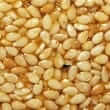Background
- Sesame (Sesamum indicum) is a flowering plant that grows throughout the world and is cultivated for its edible seeds. Sesame oil is derived from sesame seeds.
- Sesame seeds are used in foods and as flavoring agents. Sesame oil is used in cooking and for a variety of purposes, including body massage, hair treatment, and various practices of worship. Sesame oil is also commonly used as a base for preparing drugs, including those to be taken by mouth, injected, or applied to the skin. Sesame products have been added to some foods, such as snack bars, to increase nutritional value.
- Sesame oil has been used in various traditional medical systems around the word, such as Ayurveda, for anxiety, nerve and bone disorders, poor circulation, lowered immunity, and bowel and skin problems. Sesame has also been studied for use in other conditions such as heart disease, cataracts, cough, dental conditions, diabetes, high cholesterol, high blood pressure, infant massage, infertility, malnutrition, and nasal discomfort.
References
Selected references are listed below.
- Amara AA, El-Masry MH, Bogdady HH. Plant crude extracts could be the solution: extracts showing in vivo antitumorigenic activity. Pak J Pharm Sci 2008;21(2):159-71.
View Abstract - Anagnostis A, Papadopoulos AI. Effects of a diet rich in sesame (Sesamum indicum) pericarp on the expression of oestrogen receptor alpha and oestrogen receptor beta in rat prostate and uterus. Br J Nutr 2009;102(5):703-8.
View Abstract - Grougnet R, Magiatis P, Mitaku S, et al. New lignans from the perisperm of Sesamum indicum. J Agric Food Chem 2006;54(20):7570-4.
View Abstract - Harikumar KB, Sung B, Tharakan ST, et al. Sesamin manifests chemopreventive effects through the suppression of NF-kappaB-regulated cell survival, proliferation, invasion, and angiogenic gene products. Mol Cancer Res 2010;8(5):751-61.
View Abstract - Hu YM, Wang H, Ye WC, et al.[Flavones from flowers of Sesamum indicum]. Zhongguo Zhong Yao Za Zhi 2007;32(7):603-5. Chinese.
View Abstract - Hu YM, Ye WC, Yin ZQ, et al.[Chemical constituents from flos Sesamum indicum L]. Yao Xue Xue Bao 2007;42(3):286-91. Chinese.
View Abstract - Jamarkattel-Pandit N, Pandit NR, Kim MY, et al. Neuroprotective effect of defatted sesame seeds extract against in vitro and in vivo ischemic neuronal damage. Planta Med 2010;76(1):20-6.
View Abstract - Kiran K, Asad M. Wound healing activity of Sesamum indicum L seed and oil in rats. Indian J Exp Bio. 2008;46(11):777-82.
View Abstract - Liu Z, Saarinen NM, Thompson LU. Sesamin is one of the major precursors of mammalian lignans in sesame seed (Sesamum indicum) as observed in vitro and in rats. J Nutr 2006;136(4):906-12.
View Abstract - Nahar L, Rokonuzzaman. Investigation of the analgesic and antioxidant activity from an ethanol extract of seeds of Sesamum indicum. Pak J Biol Sci 2009;12(7):595-8.
View Abstract - Nasirullah, Latha RB. Storage stability of sunflower oil with added natural antioxidant concentrate from sesame seed oil. J Oleo Sci 2009;58(9):453-9.
View Abstract - Sukumar D, Arimboor R, Arumughan C. HPTLC fingerprinting and quantification of lignans as markers in sesame oil and its polyherbal formulations. J Pharm Biomed Anal 2008;47(4-5):795-801.
View Abstract - Suresh Kumar P, Patel JS, Saraf MN. Mechanism of vasorelaxant activity of a fraction of root extract of Sesamum indicum Linn. Indian J Exp Biol 2008;46(6):457-64.
View Abstract - Visavadiya NP, Soni B, Dalwadi N. Free radical scavenging and antiatherogenic activities of Sesamum indicum seed extracts in chemical and biological model systems. Food Chem Toxicol 2009;47(10):2507-15.
View Abstract - Visavadiya NP, Narasimhacharya AV. Sesame as a hypocholesteraemic and antioxidant dietary component. Food Chem Toxicol 2008;46(6):1889-95.
View Abstract

